This page is based on this
Wikipedia article Text is available under the
CC BY-SA 4.0 license; additional terms may apply.
Images, videos and audio are available under their respective licenses.

The Book of Exodus or Exodus is the second book of the Torah, the Hebrew Bible, and the Old Testament immediately following Genesis.

Moses was a prophet according to the teachings of the Abrahamic religions. Scholarly consensus sees Moses as a legendary figure, although retaining the possibility that a Moses-like figure existed.

Aaron's rod refers to any of the staves carried by Moses's brother, Aaron, in the Torah. The Bible tells how, along with Moses's rod, Aaron's rod was endowed with miraculous power during the Plagues of Egypt that preceded the Exodus. There are two occasions where the Bible tells of the rod's power.

The ark of bulrushes was a container which, according to the episode known as the finding of Moses in the biblical Book of Exodus, carried the infant Moses.

Miriam is described in the Hebrew Bible as the daughter of Amram and Jochebed, and the sister of Moses and Aaron. She was a prophetess and first appears in the Book of Exodus.
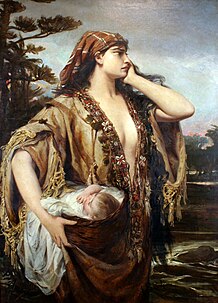
According to the Torah, Jochebed was a daughter of Levi and mother of Aaron, Miriam and Moses. She was the wife of Amram, as well as his aunt. No details are given concerning her life. According to Jewish legend, Jochebed is buried in the Tomb of the Matriarchs, in Tiberias. She is praised for her faith in the Epistle to the Hebrews.

"Creeping Death" is a song by the American heavy metal band Metallica, released as the lead and only commercial single from their second studio album Ride the Lightning (1984). Written from the perspective of the Angel of Death, it describes the tenth plague of Egypt. One of Metallica's most frequently performed songs, it has been played live 1,458 times, and it has occasionally been used on various tours as the opening song of the band's set. It stands as a classic example of the band's thrash style, albeit slower than the material on their first album, Kill 'Em All. The song's middle section, with its ominous chants of "Die!" set to a phrygian mode chord progression, is a fan participation staple during Metallica shows.

In the Book of Exodus the Plagues of Egypt are ten calamities inflicted on Egypt by Yahweh, the God of Israel, in order to force Pharaoh to allow the Israelites to depart from slavery.

Amun-her-khepeshef was the firstborn son of Pharaoh Ramesses II and Queen Nefertari.
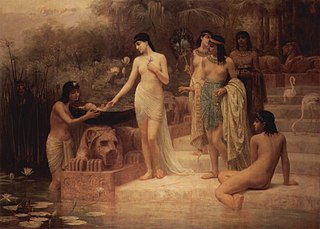
Shemot, Shemoth, or Shemos is the thirteenth weekly Torah portion in the annual Jewish cycle of Torah reading and the first in the Book of Exodus. It constitutes Exodus 1:1–6:1. The parashah tells of the Israelites' affliction in Egypt, the hiding and rescuing of the infant Moses, Moses in Midian, the calling of Moses, circumcision on the way, meeting the elders, and Moses before Pharaoh.
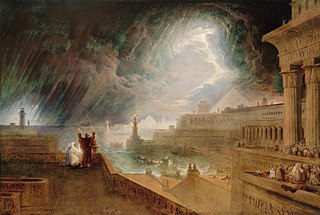
Va'eira, Va'era, or Vaera is the fourteenth weekly Torah portion in the annual Jewish cycle of Torah reading and the second in the Book of Exodus. It constitutes Exodus 6:2–9:35. The parashah tells of the first seven Plagues of Egypt.
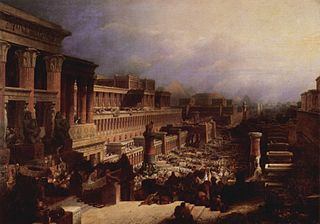
Bo is the fifteenth weekly Torah portion in the annual Jewish cycle of Torah reading and the third in the Book of Exodus. The parashah constitutes Exodus 10:1–13:16. The parashah tells of the last three plagues on Egypt and the first Passover.

Shiphrah was one of two midwives who helped briefly prevent a genocide of Hebrew children by the Egyptians, according to Exodus 1:15–21.
With a strong hand and an outstretched arm is a phrase in the Bible to describe God's use of his power on behalf of Israel, particularly during the Exodus.
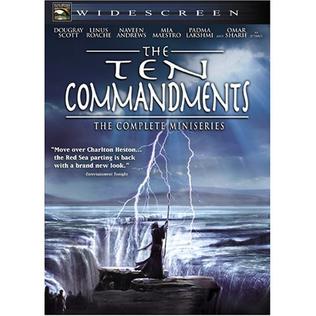
The Ten Commandments is a 2006 miniseries that dramatizes the biblical story of Moses. It ran on the ABC TV network.
Puah is a name given to two persons in the Bible:

Allusions in rabbinic literature to the biblical character Moses, who led the people of Israel out of Egypt and through their wanderings in the wilderness, contain various expansions, elaborations and inferences beyond what is presented in the text of the Bible itself.
The Hebrew Bible makes reference to various pharaohs of Egypt. These include unnamed pharaohs in the legends of the Israelite settlement in Egypt, the subsequent oppression of the Israelites, and the period of the Exodus. They also include several later rulers, some of whom can be identified with historical pharaohs.

The Staff of Moses is a staff mentioned in the Bible and Quran as a walking stick used by Moses. According to the Book of Exodus in the Bible, the staff of was used to produce water from a rock, was transformed into a snake and back, and was used at the parting of the Red Sea. Whether or not Moses' staff was the same as that used by his brother Aaron has been debated by rabbinical scholars.

















